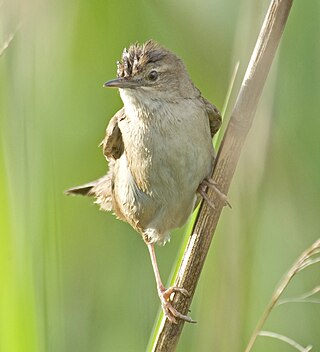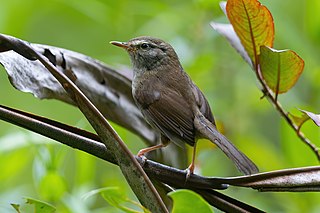Old World warblers are a large group of birds formerly grouped together in the bird family Sylviidae. They are not closely related to the New World warblers. The family held over 400 species in over 70 genera, and were the source of much taxonomic confusion. Two families were split out initially, the cisticolas into Cisticolidae and the kinglets into Regulidae. In the past ten years they have been the subject of much research and many species are now placed into other families, including the Acrocephalidae, Cettiidae, Phylloscopidae, and Megaluridae. In addition some species have been moved into existing families or have not yet had their placement fully resolved. A smaller number of warblers, together with some babblers formerly placed in the family Timaliidae and the parrotbills, are retained in a much smaller family Sylviidae.

The typical warblers are small birds belonging to the genus Sylvia in the "Old World warbler" family Sylviidae.

The grass warblers are small passerine birds belonging to the genus Locustella. Formerly placed in the paraphyletic "Old World warbler" assemblage, they are now considered the northernmost representatives of a largely Gondwanan family, the Locustellidae.

The common whitethroat or greater whitethroat is a common and widespread typical warbler which breeds throughout Europe and across much of temperate western Asia. This small passerine bird is strongly migratory, and winters in tropical Africa, Arabia, and Pakistan.

Cettia is a genus of small insectivorous songbirds ("warblers") which make up the core of the newly recognized family Cettiidae. They were formerly placed in the Sylviidae, which at that time was a wastebin taxon for the warbler-like Sylvioidea. The range of this genus extends from Europe to southeast Asia.

Bradypterus is a genus of small insectivorous songbirds ("warblers") in the newly recognized grass warbler family (Locustellidae). They were formerly placed in the Sylviidae, which at that time was a wastebin taxon for the warbler-like Sylvioidea. The range of this genus extends through the warm regions from Africa around the Indian Ocean and far into Asia.

Marmora's warbler is a typical warbler in the Sylviidae family. The specific sarda is a Latin feminine form for a person from Sardinia.

The orange-crowned warbler is a small songbird of the New World warbler family.

Tickell's leaf warbler is a leaf warbler found in Asia in the countries of Bangladesh, Bhutan, China, India, Myanmar, Nepal, Pakistan and Thailand. The species has a yellowish underside and supercilium. Like other leaf warblers it feeds mostly on insects by gleaning and short sallies. An active bird, it prefers the canopy and low shrubbery and can be difficult to track as it moves actively from branch to branch, acrobatically exploring the underside of leaves and twigs. The clear yellowish undersides and lack of a wing bar can be used to tell it apart from similar species. It has slim dark legs with largely pale lower mandible and grayish wing panel.
The pale-footed bush warbler is a species of oriental warbler in the family Cettiidae that is found in southern Asia. It occurs in the Himalayan region west from Dehradun through the foothills of Nepal to northeastern India. It also occurs in Myanmar, Laos, northern Vietnam and southern China. A single sighting was recorded from Kandy, Sri Lanka in March 1993.

The aberrant bush warbler is a species in the bush warbler family, Cettiidae. It was formerly included in the "Old World warbler" assemblage.

The Cape grassbird or Cape grass warbler is an African warbler found in southern Africa. It is the only species placed in the genus Sphenoeacus.

Neumann's warbler, also known as Neumann's short-tailed warbler, is a species of bird in the family Cettiidae. It is found in Democratic Republic of the Congo, Rwanda, and Uganda. Its natural habitat is subtropical or tropical moist montane forest.

The chestnut-headed tesia is a small insectivorous songbird formerly of the "Old World warbler" family but nowadays placed in the bush warbler family (Cettiidae).

The tesias are a genus, Tesia, of Old World warbler. Though once included in the large family Sylviidae, more recent research placed it within a new family, Cettiidae. The four species inhabit undergrowth of montane forest in South and Southeast Asia, where they are resident or short-range migrants. They have longish legs and appear tailless, with (seemingly) only 8 rectrices. Their simple songs are fairly loud, and their nests are typically ball-shaped. Their name is derived from Tisi, the Nepalese name for the grey-bellied tesia.

The Bornean stubtail is a species of bird in the cettiid warbler family Cettiidae. It is endemic to the island of Borneo, where it inhabits forest floors and undergrowth in montane forests at elevations of 750–3,150 m (2,460–10,330 ft). It is a small, short-tailed warbler, measuring 9.5–10 cm (3.7–3.9 in) in length and having an average mass of 10.4 g (0.37 oz). The tops of the head and the upperparts are brown, with whitish underparts that turn grey at the sides of the breast and the flanks. The supercilium is long and buffish-brown, with an equally long dark grey eyestripe and a thin yellow eye-ring. Both sexes are similar.

Cettiidae is a newly validated family of small insectivorous songbirds ("warblers"), formerly placed in the Old World warbler "wastebin" assemblage. It contains the typical bush warblers (Cettia) and their relatives. As a common name, cettiid warblers is usually used.

The streaked scrub warbler, also known simply as the scrub warbler, is a small passerine bird. It is the only species placed in the genus Scotocerca. It is found in northern Africa and south-western Asia. It is a bird of desert fringes, frequenting scrubby areas, ravines and gorges, and is mainly resident, although local movements can occur outside the breeding season.

Pytilia is a genus of small brightly coloured seed-eating birds in the family Estrildidae. They are distributed across Africa.

The African warblers are a newly erected family Macrosphenidae, of African songbirds. Most of the species were formerly placed in the Old World warbler family Sylviidae, although one species, the rockrunner, was placed in the babbler family, Timaliidae. A series of molecular studies of the Old World warblers and other bird families in the superfamily Sylvioidea found that the African warblers were not part of Sylviidae but were instead an early (basal) offshoot of the entire clade Sylvioidea. Some taxonomic authorities place the entire family Hyliidae here.
















